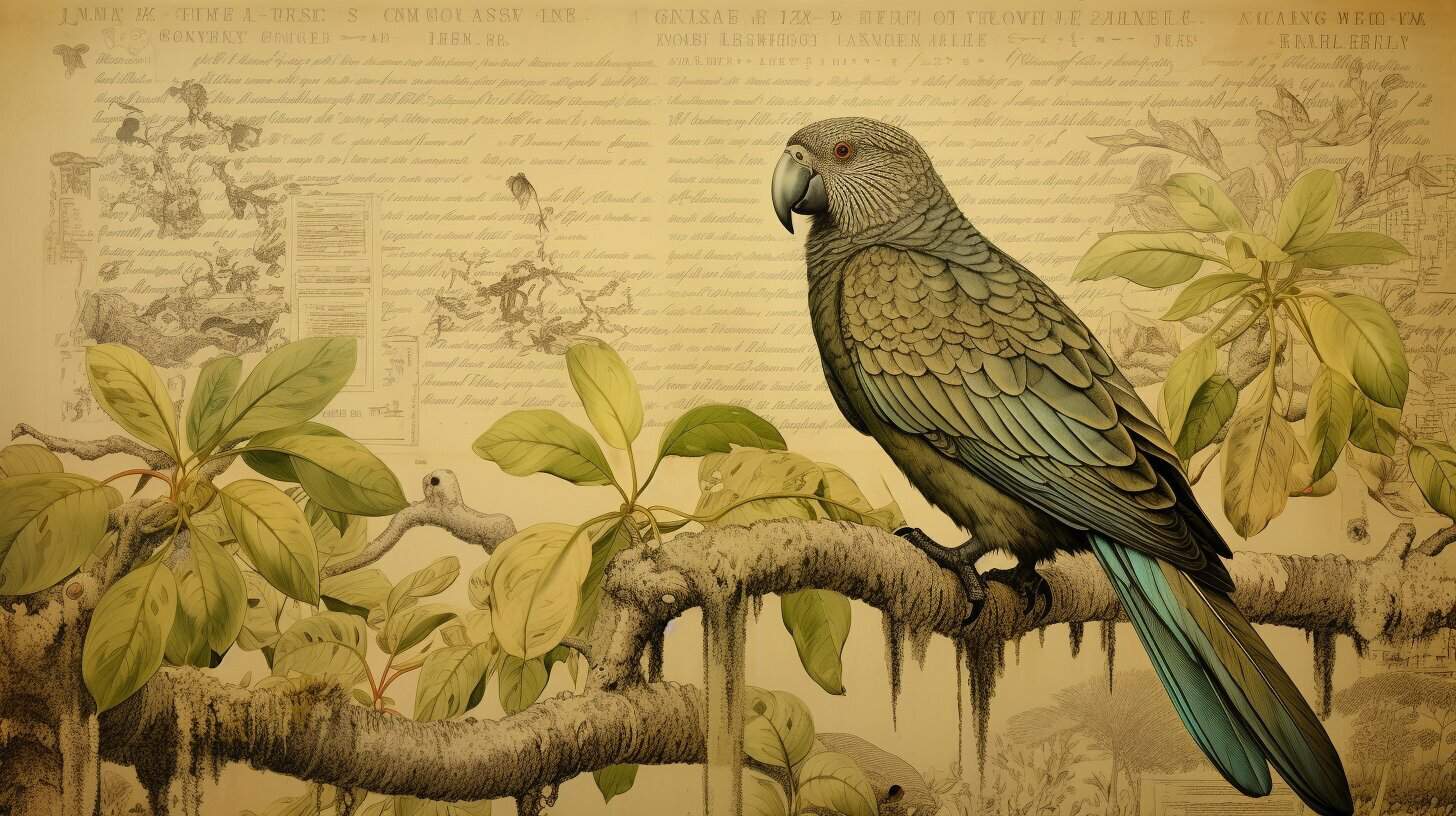With its bright green plumage and playful nature, the kakariki is a well-known and beloved bird species native to New Zealand. But have you ever stopped to wonder how this bird got its name? This article will explore the origin, meaning, and historical significance of the name “kakariki.”
Join us on a journey through time as we uncover the fascinating story behind the name of this vibrant bird. From its evolution and derivation over time to its cultural and scientific significance throughout history, we’ll leave no stone unturned in our quest for knowledge.
How Did the Kakariki Get Its Name? The Kakariki got its name from the Māori language, where “kākāriki” means green, reflecting its vibrant plumage. This New Zealand native bird’s vivid hue directly influenced its naming, echoing the lush landscapes that it often inhabits. Unmistakable and lively, the Kakariki’s name is an ode to its bright, green-feathered appearance, encapsulating its spirited nature and deep connection to its homeland’s verdant terrains.
Key Takeaways
- The name “kakariki” has a rich cultural and historical context.
- Understanding the meaning and evolution of the name enhances our appreciation for this vibrant bird.
- This article will delve into the origins of the kakariki’s name, exploring its historical significance and cultural context.
The Kakariki’s Name Origin Story
The name “kakariki” has an interesting origin story, reflecting the bird’s history and cultural significance. The word “kakariki” is a Maori word, which is the language of the indigenous people of New Zealand. The Maori people used this name to refer to a group of parakeets, which included the red-crowned kakariki, the yellow-crowned kakariki, and the orange-fronted kakariki.
The Maori deeply connect to their natural surroundings, and their language reflects this relationship. The word “kakariki” can be translated to mean “small green parrot” or “little green bird”. This name perfectly encapsulates the bird’s distinguishing characteristics, which include bright green feathers and a small size.
The name “kakariki” has evolved, reflecting the influences of different cultures and languages. For example, European explorers first encountered this bird in the 18th century and named it “New Zealand parakeet”. However, the Maori name “kakariki” has remained this bird’s most commonly used name.
The Evolution of the Kakariki’s Name
Over time, the name “kakariki” has undergone various changes and adaptations. For example, some European settlers referred to the red-crowned kakariki as the “red-fronted parakeet”. The scientific name for the kakariki is Cyanoramphus novaezelandiae, which means “blue-billed parrot of New Zealand”. This name reflects the bird’s physical characteristics, such as its blue beak.
The name “kakariki” has also been used as a brand name for products and companies, further popularising the name and increasing its recognition outside of New Zealand. For example, a skincare brand called “Kakariki” uses native New Zealand ingredients in their products.
Despite these adaptations, the name “kakariki” remains this bird’s most commonly used name, reflecting its cultural and historical significance. The name “kakariki” is not only a label for a bird but also a reflection of the values and traditions of the Maori people and New Zealand’s natural environment.
Exploring the Meaning of Kakariki
The name “kakariki” originates in the Māori language, the indigenous people of New Zealand, where the bird is predominantly found. The word “kakariki” can be broken down into two parts: “kaka” meaning parrot, and “riki” meaning small or little.
This name fits the bird as it is a small parrot species, measuring around 25 cm in length. The bird’s striking green and yellow plumage also reflects its name, as “kakariki” translates to “little green one” in Māori.
The significance of the kakariki’s name extends beyond its literal translation. In Māori culture, the kakariki holds spiritual significance and is seen as a messenger of the gods. It is believed that the bird’s arrival symbolizes good luck and fortune.
The kakariki’s name also reflects its habitat. The bird is primarily found in forests and wooded areas, where its green plumage allows it to blend in with its surroundings and remain camouflaged from predators.
Overall, the meaning of the kakariki’s name speaks to its physical characteristics and cultural significance. Understanding the name’s etymology adds a deeper appreciation for this beloved bird.
The Historical Significance of Kakariki’s Name
The name “kakariki” holds significant historical and cultural importance. In Maori culture, the bird is considered a totem animal, revered for its beauty and distinctive appearance. Early settlers in New Zealand were struck by the bird’s vibrant green plumage and lively and curious nature, inspiring them to name it the kakariki.
The scientific community recognized the kakariki’s unique characteristics, lending its name to a genus of parakeets across New Zealand and the Pacific. The word “kakariki” has its origins in the Maori language, where it means “small parrot” or “little green one.”
Throughout history, the kakariki’s name has been crucial in its conservation. The species was severely threatened by habitat loss and predation by introduced predators, leading to several conservation efforts to protect them. In the 1980s and 1990s, the Department of Conservation undertook a successful breeding program to save the kakariki from the brink of extinction. Today, the kakariki’s name continues to be essential to its conservation efforts and cultural significance in New Zealand.
Tracing the Evolution of the Kakariki’s Name
The name “kakariki” has evolved, reflecting changes in language and culture. The earliest known name for the species was the Maori name “kakariki,” which means “little parrot.” Europeans who encountered the bird in the 18th century initially called it the “green parakeet” before adopting the Maori name.
As the bird became more widely known, its name continued to evolve. In the 19th century, some naturalists called it the “grass parakeet,” referencing its habitat in grassy areas. However, the name “kakariki” remained the bird’s most common and enduring name.
Today, the name “kakariki” is recognized internationally as the standard name for the species. It is used by ornithologists and bird enthusiasts worldwide, reflecting the bird’s widespread appeal and popularity.
The Cultural Significance of the Kakariki’s Name
The name “kakariki” carries significant cultural weight in the region of New Zealand, where the bird is native. It has been an important species for the Māori people, who have a rich cultural history intertwined with the natural world.
The Māori people used the bright green feathers of the kakariki for clothing and body decoration, reflecting their reverence for the bird’s beauty and importance in their culture.
Several legends and stories are associated with the kakariki in Māori folklore. In one such story, the bird is said to have saved the Māori people from a flood by leading them to higher ground.
“The name ‘kakariki’ carries significant cultural weight in the region of New Zealand, where the bird is native. It has been an important species for the Māori people, who have a rich cultural history intertwined with the natural world.”
The kakariki’s cultural significance extends beyond the Māori people as well. The bird has become an emblem for the conservation movement in New Zealand, representing the importance of preserving the natural world and its creatures.
Today, the kakariki’s name remains an important cultural identity and environmental conservation symbol. Its rich history and cultural significance inspire admiration and respect for this vibrant, green bird.
The Kakariki’s Name in Cultural Context
The kakariki has long been an important cultural symbol among the indigenous Māori people of New Zealand. Known for its vibrant green plumage, this bird has featured prominently in Māori art, music, and mythology.
The Māori name for the kakariki is “kākāriki,” which derives from “kākā” (parrot) and “riki” (small). Traditionally, the Māori people believed that birds were messengers from the gods, and the kakariki was often seen as a spiritual guide or protector.
According to Māori legend, the kakariki was once a human prince who was transformed into a bird by a powerful sorceress. As a result, the kakariki was seen as a symbol of transformation and rebirth and a reminder of the importance of balance and harmony in nature.
“In Māori mythology, birds are often seen as messengers from the gods, and the kakariki is no exception. Its vibrant green colouring symbolises growth, renewal, and new beginnings.”
Today, the kakariki holds a special place in Māori culture, and efforts are being made to conserve and protect this endangered species. Through its representation in art and folklore, the kakariki serves as a reminder of the rich cultural heritage and natural diversity of New Zealand.
The Significance of the Kakariki’s Name Today
The name “kakariki” holds immense significance in the contemporary context, particularly concerning conservation efforts and cultural appreciation of the bird.
As a result of habitat loss and introduced predators, the kakariki has faced significant threats to its existence. The name “kakariki” symbolises hope for conservationists and bird enthusiasts alike, inspiring efforts to protect and restore the bird’s natural habitat.
Additionally, the cultural significance of the kakariki’s name continues to resonate within indigenous communities. The bird holds a special place in Maori mythology and is often featured in traditional stories and artwork. Its name serves as a reminder of the deep connection between indigenous people and the natural world.
Furthermore, “kakariki” has become synonymous with vitality, vibrancy, and beauty. These qualities are exemplified in the bird’s striking green plumage and playful antics. As a result, the name has become a popular choice for businesses and products seeking to convey a sense of energy and vitality.
Overall, the significance of the kakariki’s name today is multi-faceted and far-reaching. It symbolises hope, cultural significance, and natural beauty, inspiring conservation efforts and promoting appreciation for this unique and fascinating bird.
The Significance of the Kakariki’s Name Today
Understanding the origin and evolution of the kakariki’s name provides valuable insight into the cultural and historical context surrounding this vibrant bird. Today, the name holds great significance in the conservation and appreciation of the species.
As an emblem of New Zealand’s unique biodiversity, the kakariki’s name is now widely recognized and celebrated locally and internationally. Its name has become synonymous with environmental awareness and conservation efforts, a powerful reminder of the need to protect and preserve our natural world.
Furthermore, the name also reflects the bird’s vibrant character and personality. The name “kakariki” is not just a label but a description of the bird’s bright and lively demeanour. It captures the essence of the bird’s playful and joyful nature, making it a fitting name for this energetic and charismatic species.
In conclusion, the name of the kakariki is not merely a word but a window into its cultural and historical significance. By understanding its name, we can better appreciate and protect this unique and precious species for future generations.
FAQ
Q: What is the meaning of the name “kakariki”?
A: The word “kakariki” translates to “green” in Maori, referencing the bird’s vibrant green plumage.
Q: How did the kakariki get its name?
A: The name “kakariki” was bestowed upon the bird due to its striking green colouration, a distinctive characteristic of this species.
Q: What is the historical significance of the kakariki’s name?
A: The name “kakariki” holds cultural and scientific significance throughout history, representing the bird’s unique attributes and habitat.
Q: Has the kakariki’s name evolved over time?
A: Yes, the kakariki’s name has seen changes and adaptations over time, reflecting linguistic influences and cultural developments.
Q: Are there any legends or folklore associated with the kakariki’s name?
A: While not specifically tied to the kakariki’s name, the bird holds cultural importance in the folklore and traditions of the Maori people.
Q: What linguistic influences have shaped the kakariki’s name?
A: The kakariki’s name has been influenced by indigenous languages, such as Maori, and external linguistic influences over the years.
Q: Why is the kakariki’s name significant today?
A: Understanding the meaning and history of the kakariki’s name is essential in fostering conservation efforts and appreciating the bird’s beauty and cultural importance.



Have comments or questions about this article? Then get involved!
Spotted an error or something we have missed? Let us know